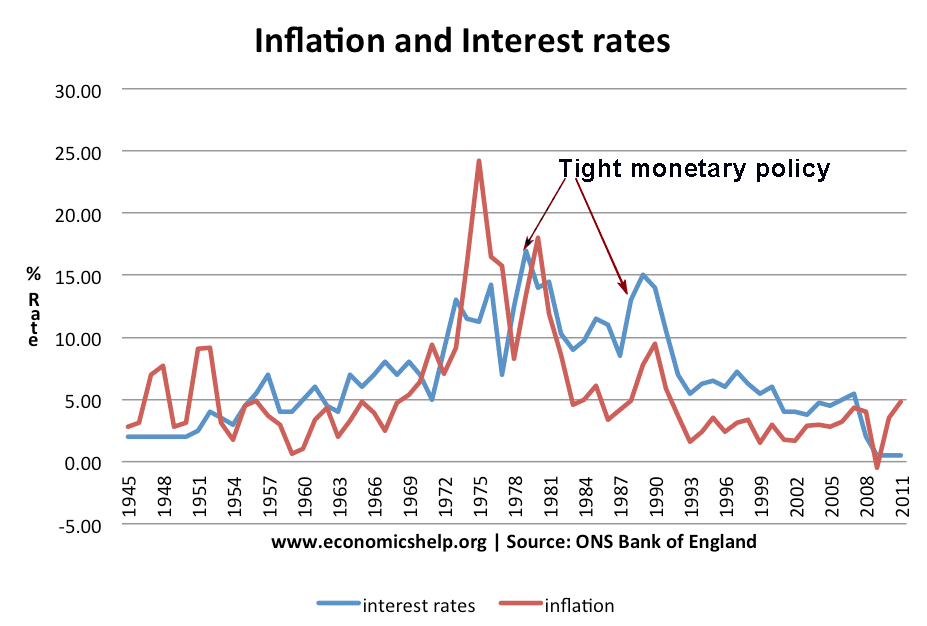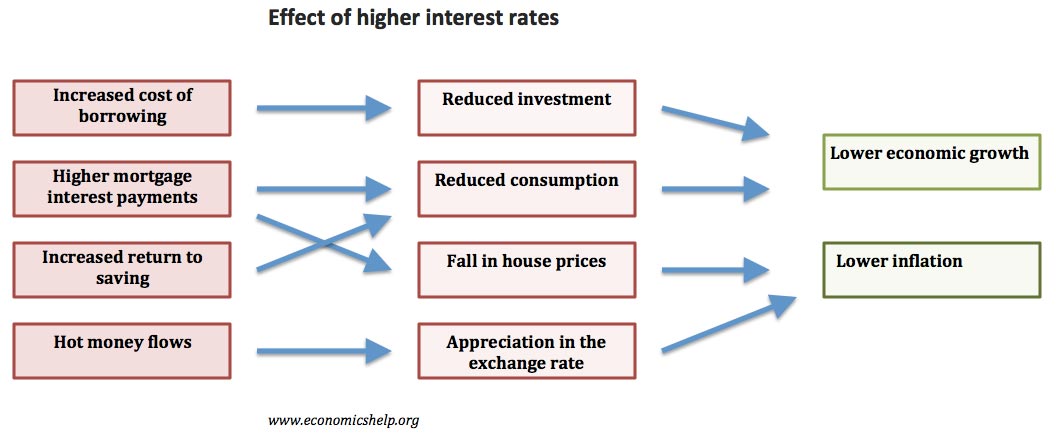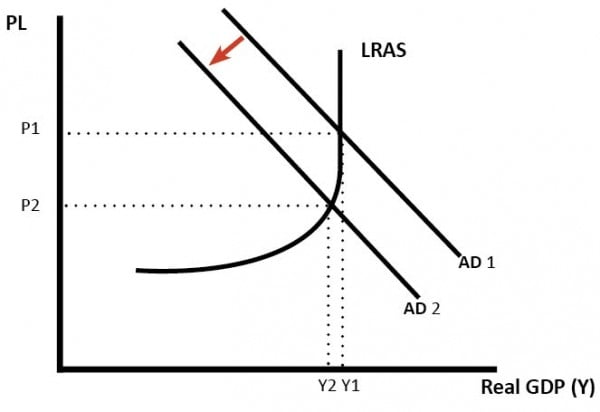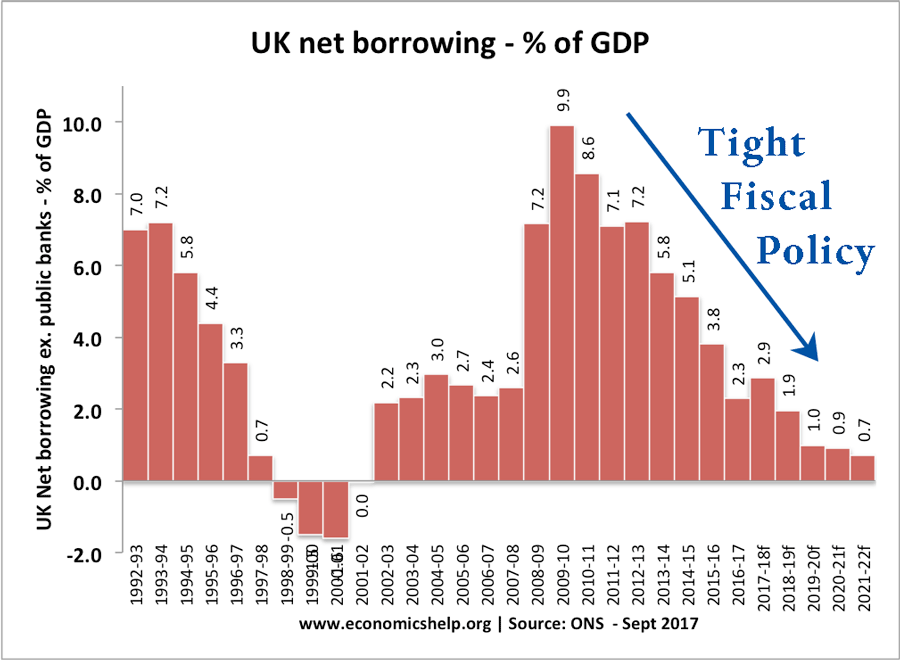In the real world the actual money multiplier tends to be smaller than 1rr because. We set monetary policy to achieve the Governments target of keeping inflation at 2. A tight money policy that is designed to decrease inflation.
A Tight Money Policy That Is Designed To Decrease Inflation, The Feds ideal inflation rate is around 2if its higher than that demand will drive up prices for too few goods. The Reserve Bank is responsible for Australias monetary policy. When the government pursued a tight money policy during the Great Depression it caused aggregate demand to decrease because it.
 Monetary Policy Regulating Money Supply 2 Types From present5.com
Monetary Policy Regulating Money Supply 2 Types From present5.com
In the real world the actual money multiplier tends to be smaller than 1rr because. The Federal Reserve uses three. The economy experiences inflationary pressures due to rising consumers demand for goods and services and there is also boom in business investment. Tight or contractionary monetary policy is a course of action undertaken by a central bank such as the Federal Reserve to slow down overheated economic growth to constrict spending in.
The Fed will enact one or more.
What effect does a tight money policy have on the reserve requirement and the economys money supply. Occurs when Fed tries to decrease money supply by decreasing excess reserves in order to slow spending in the economy during an inflationary period. The Feds ideal inflation rate is around 2if its higher than that demand will drive up prices for too few goods. A monetary policy designed to curtail aggregate demand is called restrictive or dear monetary policy. Monetary policy involves setting the interest rate on overnight loans in the money market the cash rate. People hold some loaned money as cash.
Read another article:
 Source: chegg.com
Source: chegg.com
Tight or contractionary monetary policy 1. We also support the Governments other economic aims for growth and employment. We set monetary policy to achieve the Governments target of keeping inflation at 2. Banks do not loan out all of excess their reserves. Solved A Central Back Engages In Tight Monetary Policy In Chegg Com.
 Source: researchgate.net
Source: researchgate.net
CYCLICAL ASYMMETRY may exist. A contractionary monetary policy also called a tight monetary policy reduces the quantity of money and credit below what it otherwise would have been and raises interest rates seeking to hold down inflation. We also support the Governments other economic aims for growth and employment. It is used to overcome an inflationary gap. Effect Of Tight Monetary Policy Through Demand Side Channels Download Scientific Diagram.
 Source: khanacademy.org
Source: khanacademy.org
People hold some loaned money as cash. Japans ineffective easy money policy illustrates the potential inability of monetary policy to bring an economy out of recession. CYCLICAL ASYMMETRY may exist. A monetary policy designed to curtail aggregate demand is called restrictive or dear monetary policy. Monetary Policy Tools Video Khan Academy.
 Source: economicshelp.org
Source: economicshelp.org
Under the Policy Targets Agreement PTA the Reserve Bank is required to keep future CPI inflation outcomes between one percent and three percent on average over the medium term although it is acknowledged that isolated price movements can justify outcomes outside. Contractionary monetary policy is a strategy used by a nations central bank during booming growth periods to slow down the economy and control rising inflation. What effect does a tight money policy have on the reserve requirement and the economys money supply. The cost to a household for daily necessities such as. Tight Monetary Policy Economics Help.
 Source: courses.lumenlearning.com
Source: courses.lumenlearning.com
High inflation can lead to hyperinflation if it is not controlled. A tight money policy that is designed to decrease inflation is in conflict with from ECON 224 at American InterContinental University. Japans ineffective easy money policy illustrates the potential inability of monetary policy to bring an economy out of recession. Under the Policy Targets Agreement PTA the Reserve Bank is required to keep future CPI inflation outcomes between one percent and three percent on average over the medium term although it is acknowledged that isolated price movements can justify outcomes outside. Reading Monetary Policy And Aggregate Demand Macroeconomics.
 Source: ibeconomist.com
Source: ibeconomist.com
Phillips found that a decrease in the unemployment rate was only achieved by the short-term increase in inflation. Tight or contractionary monetary policy 1. Contractionary monetary policy is a strategy used by a nations central bank during booming growth periods to slow down the economy and control rising inflation. Banks loan out all of their excess reserves. 2 5 Monetary Policy The Ib Economist.
 Source: economicshelp.org
Source: economicshelp.org
To control inflation the Fed must use contractionary monetary policy to slow economic growth. Tight or contractionary monetary policy is a course of action undertaken by a central bank such as the Federal Reserve to slow down overheated economic growth to constrict spending in. To control inflation the Fed must use contractionary monetary policy to slow economic growth. When unemployment drops skilled workers find jobs and. Tight Monetary Policy Economics Help.

Low and stable inflation is good for the UKs economy and it is our main monetary policy aim. Banks do not loan out all of excess their reserves. Tight or contractionary monetary policy is a course of action undertaken by a central bank such as the Federal Reserve to slow down overheated economic growth to constrict spending in. To control inflation the Fed must use contractionary monetary policy to slow economic growth. Understanding Supply Side Economics.
 Source: rbnz.govt.nz
Source: rbnz.govt.nz
Its aim is to reduce the pressure caused by high inflation and to cool the economy. Low and stable inflation is good for the UKs economy and it is our main monetary policy aim. A contractionary monetary policy is a monetary policy aimed at reducing the money supplys growth rate in the economy. Phillips found that a decrease in the unemployment rate was only achieved by the short-term increase in inflation. Monetary Policy And Inflation Reserve Bank Of New Zealand.
 Source: www2.harpercollege.edu
Source: www2.harpercollege.edu
Tight or contractionary monetary policy 1. Low and stable inflation is good for the UKs economy and it is our main monetary policy aim. Monetary policy involves setting the interest rate on overnight loans in the money market the cash rate. We also support the Governments other economic aims for growth and employment. Mpsummary.
 Source: nzier.org.nz
Source: nzier.org.nz
A contractionary monetary policy also called a tight monetary policy reduces the quantity of money and credit below what it otherwise would have been and raises interest rates seeking to hold down inflation. Its aim is to reduce the pressure caused by high inflation and to cool the economy. A contractionary monetary policy is a monetary policy aimed at reducing the money supplys growth rate in the economy. A tight money policy that is designed to decrease inflation is in conflict with from ECON 224 at American InterContinental University. Monetary Policy Nzier.
 Source: present5.com
Source: present5.com
A contractionary monetary policy also called a tight monetary policy reduces the quantity of money and credit below what it otherwise would have been and raises interest rates seeking to hold down inflation. A tight monetary policy works effectively to brake inflation but an easy monetary policy is not always as effective in stimulating the economy from recession. The effect of lower unemployment on inflation mirrors the effect of high employment on labor and product markets. When the government pursued a tight money policy during the Great Depression it caused aggregate demand to decrease because it. Monetary Policy Regulating Money Supply 2 Types.
 Source: slidetodoc.com
Source: slidetodoc.com
Tight or contractionary monetary policy is a course of action undertaken by a central bank such as the Federal Reserve to slow down overheated economic growth to constrict spending in. During the 20082009 recession central banks around the world also used quantitative easing to expand the supply of credit. Tight or contractionary monetary policy is a course of action undertaken by a central bank such as the Federal Reserve to slow down overheated economic growth to constrict spending in. When the government pursued a tight money policy during the Great Depression it caused aggregate demand to decrease because it. Monetary Policy Economics Understanding Inflation Definition Of Inflation.
 Source: economicshelp.org
Source: economicshelp.org
Contractionary monetary policy is a strategy used by a nations central bank during booming growth periods to slow down the economy and control rising inflation. High inflation can lead to hyperinflation if it is not controlled. When the government employs a tight fiscal policy we should expect that A the level of output will only be affected by a small amount B interest rates will increase C monetary policy will be easy at the same time D inflation will be lowered more than unemployment E the budget deficit will decrease. During the 20082009 recession central banks around the world also used quantitative easing to expand the supply of credit. Tight Monetary Policy Economics Help.
 Source: economicshelp.org
Source: economicshelp.org
When the government pursued a tight money policy during the Great Depression it caused aggregate demand to decrease because it. A tight money policy that is designed to decrease inflation is in conflict with from ECON 224 at American InterContinental University. The cost to a household for daily necessities such as. It is used to overcome an inflationary gap. Tight Fiscal Policy Economics Help.







